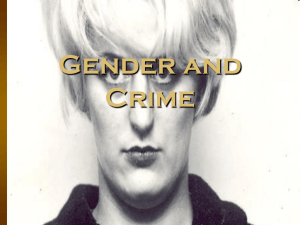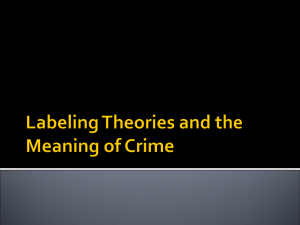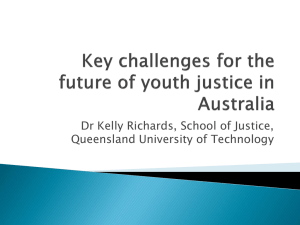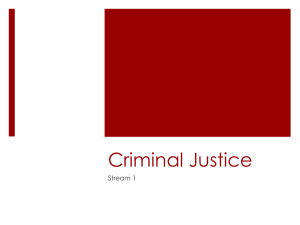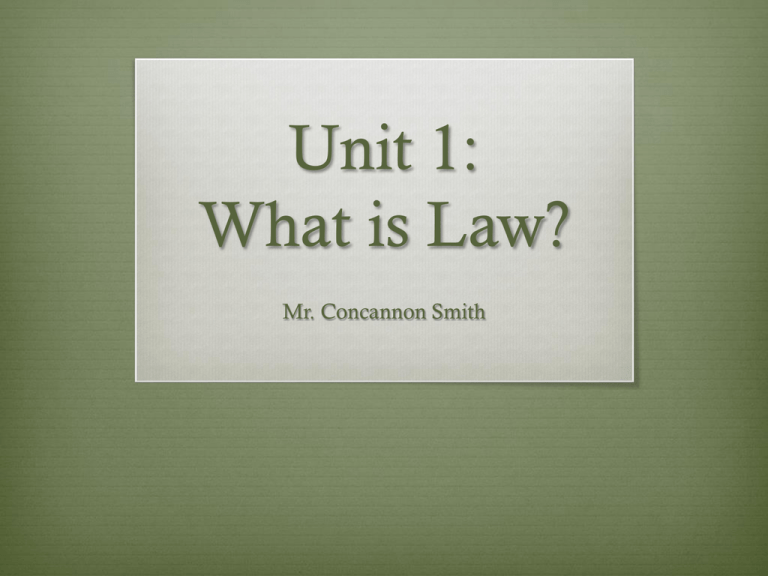
Unit 1:
What is Law?
Mr. Concannon Smith
Do Now
1. List 10 of your daily activities (for example,
waking up, eating, etc.).
2. Next to each item, list any laws that affect that
activity.
3. What is the Purpose of each law you
identified?
4. Would you change any of these laws?
Why/why not?
Unit 1:
What is Law?
Mr. Concannon Smith
What is Law?
Law: the rules and regulations made and enforced by a
society’s government to manage the conduct of the people
within said society.
Every society that has ever existed has recognized the need
for laws (written or unwritten)
This does NOT mean all laws are “fair” or “good”
A democratic system of govt. (like ours) cannot function
unless the laws are respected by the people they are intended
to regulate.
Society must be based on the “rule of law”
Rules should be known in advance and created democratically
Nobody is above the law (example: Nixon)
Laws and Values
Laws generally reflect and promote societal values (traditional
ideas about right and wrong)
Not everything immoral is illegal (ex. lying to a friend)
Goals of the legal system according to legal scholars:
•
Protecting basic human rights
•
Promoting fairness
•
Resolving conflicts
•
Promoting order/stability
•
Promoting desirable economic and social behavior
•
Representing the will of the majority
•
Protecting the rights of minorities (non-racial usage)
Value-laden Law Examples
1. Moral Values: Right and Wrong
Murder = primary moral value of protection of human life
2. Economic Values: accumulation, use of, and dist. of wealth
Tax laws = encourage people to own a home (tax benefits)
Shoplifting laws = protect property and discourages stealing
3. Political Values: relationship between people an government
Voting holidays = easier for citizens to participate in elections
Anti-corruption laws = keep public trust in elected officials
4. Social Values: broadest category, issues important to society
Public education = country’s best interest to educate youth
Social Contract Theory
In a nutshell:
The voluntary agreement to limit our own rights
and freedoms to a government in order to
maintain social and political order
The degree to which we submit to this agreement
is constantly under debate
Social contract on the day to day:
Ranges from stop signs and speed limits to the
Patriot Act
Can you think of any others?
Do Now
What do you think it means to have
a right? (what is the meaning of a
“right”)
Are you born with any basic rights,
and if so what are they?
Where did they come from?
Are there some rights that are more
important than others?
Mr. Concannon Smith
Human Rights
Human Rights: the rights all people have simply because they
are human.
The Universal Declaration of Human Rights (UDHR) is a
statement of basic human rights and acts as a set of standards
by which nearly every country in the world follows.
Developed by the UN under Eleanor Roosevelt in 1948
Basic UDHR rights: Liberty, Education, political and religious
freedom, and economic well-being
UDHR also bans torture
The UDHR is not a binding treaty but many ideals in the
UDHR have been ratified in treaties
Rights vs. Responsibility
Human Rights can be used by countries when writing laws
Rights are codified by signing HR treaties, amending the
Constitution, or passing laws specifically aimed at a HR issue
Some criticize the “over-codification” of rights in the U.S.
If we consider trial by jury a right, we shouldn’t complain
about serving on a jury
If we want a government for the people & by the people, we
should actually get out and vote
Further criticism…just because we have first amendment rights
doesn’t mean saying hateful things is morally correct
Striking the correct balance between right & responsibility is
difficult!
Kinds of Laws
Mr. Concannon Smith
Two Major Categories
Criminal Law
Regulates public conduct
and sets out duties owed to
society
Can only be brought by
the govt. against a person
charged with committing a
crime
Offenses divided into
felonies and misdemeanors
Penalties: incarceration,
probation, fines
Civil Law
Regulates relations
between individuals or
groups of individuals
Examples: marriage,
divorce, contracts,
insurance, car accidents
A civil action is a lawsuit
brought by a person who
feels wronged or injured by
another person
Penalty: recovery of
damages
Important Distinctions
A criminal case is brought by the government against a
defendant
A civil case is brought by a plaintiff against the defendant.
In a CRIMINAL CASE, the burden on the prosecution is to
prove the guilt of the defendant beyond a reasonable doubt
In a CIVIL CASE, the plaintiff wins by convincing the judge
or jury by a preponderance of the evidence
These are called standards of proof
Why do you think the standard of proof is lower in CIVIL
CASES?
Our Constitutional
Framework
Mr. Concannon Smith
Must Know Basics
The U.S. Constitution is the highest law of the land.
Sets the framework, powers and limitations of
government
Limited Government is the fundamental notion in the
Const.
Logically so, given the history
The Separation of Powers is perhaps the most important
component of the Constitution
Three branches: Executive, Legislative, and Judicial
Checks and Balances: designed to ensure that one
branch cannot rule supreme over the others
Judicial Review
The Court’s power to declare unenforceable any law
passed by Congress or a state that conflicts with the
Constitution
In general SCOTUS can declare a law unconstitutional
1. govt. has passed a law that the Constitution does not give
it power to pass
2. govt. passed a law that violates somebody’s rights
SCOTUS can also declare an Executive Act
unconstitutional
1. Can strike down regulations issued by executive branch
Is there any potential weakness in this power?
Federalism
defined: the division of power between the
federal government and the states
(remember: the federal govt’s power to
make law is written explicitly in the
Constitution, the remaining powers are left
to the states)
Since states have their own power to make
laws, many states have different laws
regulating the same behaviors/crimes/etc.
The Bill of Rights
The first 10 Amendments to the Constitution
They define and guarantee the fundamental rights
and liberties of all Americans.
These include but are not limited to:
Freedom of religion
Freedom of speech and press
Freedom from unreasonable search and
seizure
Lawmaking
•US citizens obey three main sources of law (federal,
state, and local).
•Legislative bodies in each category make the laws.
•In some situations laws can be made directly by
voters, and in other courts can set law by ruling on
appeals.
Do Now
Decide whether each of the following is a federal, state, and/or a
local law:
A. No parking on the east side of Main St. between 4 and 6 pm.
B. All persons between the ages of 6 and 16 must attend school
C. Whoever enters a bank for the purposes of taking by force or violence
the money from said bank shall be fined not more than $50,000 or
imprisoned not more than 20 years, or both.
D. In order to sell any product on the public streets a vendor must first
apply for and receive a vendor’s permit
E. No employer of more than 15 persons may discriminate on the basis
of race, color, religion, sex, or national origin
F. All persons traveling on interstate airlines are subject to search before
entering the plane prior to departure
Legislatures
Federal level: Congress divided into two houses (HOR and
Senate)
Laws passed at this level are binding in every state (called statutes)
Deal with issues of national impact: environment, public health,
national defense, labor relations, civil rights, federal taxes
State level: state legislatures (most of which are bicameral also)
operate the same way and make laws that are only binding within
their boundaries.
State statues deal with statewide issues: education, transportation,
state taxes, marriage, most criminal laws, the power of state officials
City/Town level: pass laws known as ordinances
Local issues: land use, parking, schools, etc.
Drafting a Bill
Mr. Concannon Smith
Drafting a Bill
Many drafts are written before bills are formally introduced
and discussed by a legislative body
Despite such efforts, interpretation can become an issue
This violates a basic principle of law (people knowing the law)
Thus CLARITY is key when drafting bills: the checklist
Is the law written in clear language?
Is the law understandable?
When does the law go into effect?
Does the law contradict any other laws?
Is the law enforceable, and if so by whom?
Are the penalties for breaking the law clear and reasonable?
Your Lawmakers
Mr. Concannon Smith
Do Now
Federal Level:
Can you name who represents Massachusetts
in the House of Representatives for your
district?
How about our two Senators?
State Level:
State Representative
State Senator
Truancy Law 7/1/2014
Chapter 76, section 1 of the Massachusetts General Laws
states that all children between the ages of six and sixteen
must attend school. A school district may excuse up to
seven day sessions or fourteen half day sessions in any
period of six months. In addition to this law, each school
may have its own attendance policy with which
parents/guardians should be familiar.
Inducing Absences
It is a crime to induce or attempt to induce a minor to miss
school, or unlawfully to employ or to harbor a minor who
should be in school.
CJ in your District
Harriet Chandler (D)
Bill concerning teaching
health in schools
Kimberly Ferguson (R)
Bill concerning the
insanity defense for
criminals
Analyzing Bills
Chandler: Teaching Health
Ferguson: Criminally Insane
When was the bill
When was the bill
What change is it trying to
What change is it trying to
introduced?
make?
Provide evidence from the
bill
introduced?
make?
Provide evidence from the
bill
Why do you think the Senate
Why do you think the House
Do you agree with this bill?
Do you agree with this bill?
is concerned about what goes
on in a high school health
class?
Explain why/why not…
is concerned about the
permanent criminal record of
those who pleaded insane?
Explain why/why not…
Advocacy in Law
Lobbying Webquest
Mr. Concannon Smith
Advocacy
Defined: the active support of a cause.
Advocates try to persuade others to support the
same cause
Advocacy (done well) is based on:
Gathering of facts
Developing outreach and communication
An effective plan and timeline
Determining the level of government
responsible for the targeted legal changes you
hope to make
Lobbying
Defined: a way to influence the lawmaking process by
convincing the lawmakers to vote as you want them to vote.
17th century roots: interested persons had to wait outside
political meetings until the politicians came out (in the lobby)
Lobbying today carries a negative connotation, but is actually a
protected Constitutional right.
Free speech, freedom of assembly and press
A lobbyist, is someone who works for an interest group to sway
legislation by convincing lawmakers to vote in their interest
You can lobby as an individual or as a group: write letters,
protest, start a petition, phone-call campaigns, email, etc.
What is Crime?
Mr. Concannon Smith
What is Crime?
An act becomes a crime when it meets the
legal definitions that designate it as such
Simply stated: it is an wrongful act against
society––proclaimed by law––and is
punishable by society.
The Consensus Model
Rests on the assumption that members of society form a
basic agreement with regard to norms and social values
Those members whose actions deviate from the norm
pose a threat to the well being of society as a whole
punished.
Laws are passed to control & prevent deviant behavior
Underlying assumption: a diverse group of people can
have similar morals (sharing ideas about what’s
right/wrong)
as public attitudes toward morality change so too do
laws!
The Conflict Model
Rejects the consensus model on grounds that in the US,
moral attitudes are not constant or consistent
Different groups of citizens hold widely varying opinions
on issues of morality and criminality: abortion, war on
drugs, gun control, voter ID, immigration, same sex
marriage etc.
The Conflict Model holds that the most politically
powerful segments of society (based on class, income, age,
& race) have the most influence on criminal law
Consequence: this group imposes their values on the
rest of the community
This changes with whatever group comes to power
Criminal v. Deviant
Deviance is simply behavior that
does not conform to the norms of
society (very subjective)
Deviant acts become crimes only
when society as a whole (through
its legislatures) determine that
such acts should be punished.
Types of Crime:
Six Major Categories
Mr. Concannon Smith
1. Violent Crimes
These crimes dominate public perspectives on crime
(considered the most heinous offenses)
Examples include:
Murder: unlawful killing of a human being
Sexual Assault/Rape: coerced actions––sexual in nature––
against an unwilling participant
Assault and Battery: two separate acts
Assault: threats on another person of physical harm (perceived
truth)
Battery: physical attack on another individual
Robbery: taking of funds/personal property by means of force
These crimes are classified by degree more on this later…
2. Property Crime
Most common form of crime
Larceny (theft): pocket picking, shoplifting, or
stealing property not accomplished by force
Burglary: act of unlawfully entering a home or
structure with the intent of committing a
crime like theft (usually a felony)
Arson: malicious and intentional burning of a
home, automobile or other structure
3. Public Order Crime
Behavior labeled criminal because it is
contrary to shared social values (think
Consensus Model)
Sometimes called Victimless Crimes (however
misleading):
Examples include:
Public drunkenness, gambling, illicit
drug use, prostitution, disturbing the
peace, loitering, etc.
4. White-Collar Crime
Business related crime: an illegal act––carried out
non-violently––against individuals or other
businesses to obtain a personal or business
advantage.
Examples include:
Embezzlement: using position in company to
steal funds from the company
Tax Evasion: underreporting or not reporting
taxable income
Fraud: Credit Card, Check, Securities (stock
market), consumer fraud (counterfeits), insurance
5. Organized Crime
Illegal acts by illegal organizations usually
geared toward satisfying the public’s demand
for unlawful goods/services
Conspiratorial in nature.
Criminal tactics include (but certainly not
limited to) violence, corruption, intimidation,
fraud, trafficking (both narcotics and
humans)
All for economic gain and power
6. High-Tech Crime
Newest variation on crime
Examples of Cybercrime:
Selling illegal porn
Soliciting minors
Defrauding consumers
Embezzlement
Cyber security attacks
The Criminal Justice Process
Mr. Concannon Smith
Law Enforcement
Local and County Law Enforcement
Responsible for the “nuts and bolts” of law enforcement.
State Law Enforcement
Generally, there are both “state police” and “highway patrols.”
Federal Law Enforcement: Operates throughout the U.S.
The Courts
The U.S. has a dual court system. (two independent
judicial systems)
1. Federal system (federal laws)
2. State (state laws) + Washington D.C.
Technically we have 52 different court systems
Criminal Courts in each system determine the
innocence or guilt of criminal suspects within their
individual jurisdiction
The Criminal Justice Process
The Criminal Justice Process
An orderly progression of events through a process comprised
of agencies working together.
Herbert Packer compared the idealized criminal justice process
to an assembly line.
The line is constantly at work and faces congestion!
Partial solution is discretion:
Authority to choose alternative courses of action
All facets of the system employ discretion to maximize use of
limited resources
The informal criminal justice system: flexible and conditional
The CJ Process: Day 2
Mr. Concannon Smith
The Wedding Cake Model
Discretion comes to bear depending on the relative
importance of a particular case
1. “Top” layer consists only of a handful of celebrity
cases
2. Second layer consists of “high profile” felonies
3. Third layer consists of “ordinary” felonies
4. Fourth layer consists of misdemeanors
Top layer distorts our view of the system
Over 90% of criminal cases (including felonies) are
settled OUT OF COURT
Competing Values of the System
Crime Control
The most important
function of system is to
punish and repress criminal
conduct
Law enforcement must be
counted on to control
criminal activity
Due Process
Focus on protecting the
rights of the accused
through legal constraints on
police, courts, and
corrections
Strives to make it more
difficult to prove guilt
The system should function
Fairness, not efficiency, is
efficiently, as an assemblyline
the goal of the due process
model
Careers in CJ
Crime Scene Photographer
Criminal Justice Today
Mr. Concannon Smith
Major Issues Today
Community Relations & Law
Enforcement
Think Ferguson, MO
The Scourge of Street Gangs
Chicago, LA, NYC, ATL
Gun Sales and Gun Control
Think Sandy Hook
The Illegal Drugs Problem
Think marijuana in Colorado
Policy Quandaries
Crime and Punishment
The Growing Prison Population
The Economics of Incarceration
The Death Penalty in America
Homeland Security and the Threat of
Terrorism
The Patriot Act
Technology: Fighting and Fueling Crime
Gang Problems
Approx. 33,000 violent street gangs, motorcycle gangs, and
prison gangs with about 1.4 million members are criminally
active in the U.S. today.
Many are sophisticated and well organized
all use violence to control neighborhoods and boost their illegal
money-making activities, which include robbery, drug and gun
trafficking, fraud, extortion, and prostitution rings.
Gangs are responsible for an average of 48% of violent crime
in most jurisdictions, and up to 90% in others.
The FBI w/ local and state police to disrupt and dismantle
gangs through intelligence-driven investigations
Reading on Chicago Gun
Violence




